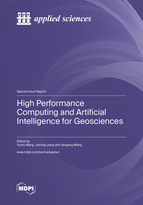High Performance Computing and Artificial Intelligence for Geosciences
A special issue of Applied Sciences (ISSN 2076-3417). This special issue belongs to the section "Earth Sciences".
Deadline for manuscript submissions: closed (30 April 2023) | Viewed by 18388
Special Issue Editors
Interests: high-performance computing; parallel computing; artificial intelligence; distributed machine learning
Special Issues, Collections and Topics in MDPI journals
Interests: high performance computing; parallel computing; GPU; artificial intelligence
Special Issue Information
Dear Colleagues,
The Special Issue is devoted to meeting the increasing demand for research on high-performance computing and artificial intelligence in geosciences. Nowadays, geosciences have become one of the most data-rich fields in terms of quantity and diversity. In order to better process and utilize the ever-increasing datasets, there are great challenges to apply the state-of-the-art computing methods to big data in geoscience. The development of the supercomputer has opened up a new path for geoscience research, and its powerful computing and storage capacity provides an unprecedented efficient platform for massive data processing and numerical simulation. At the same time, artificial intelligence based on deep learning and big data has been widely used in natural language processing, image recognition, etc.
This Special Issue aims to encourage researchers to study advanced methods of high-performance computing and artificial intelligence to solve problems of geosciences, including, but not limited to, the following sub-disciplines: atmospheric science, ocean science, geography, geology, and geophysics. These methods can range from improving or training statistical learning, machine learning, or deep learning algorithms and applying them to analyze text, images, GIS, and other data and using high-performance computing to accelerate computational problems in geosciences.
Topics of interest include, but are not limited to, the following:
- High-performance computing of earth system models;
- Massively parallel computing;
- AI-accelerated numerical weather prediction;
- Solving geoscience problems on supercomputers;
- Knowledge graph construction;
- Data mining in geosciences;
- Image recognition based on deep learning;
- Natural language processing.
Dr. Yuzhu Wang
Prof. Dr. Jinrong Jiang
Prof. Dr. Yangang Wang
Guest Editors
Manuscript Submission Information
Manuscripts should be submitted online at www.mdpi.com by registering and logging in to this website. Once you are registered, click here to go to the submission form. Manuscripts can be submitted until the deadline. All submissions that pass pre-check are peer-reviewed. Accepted papers will be published continuously in the journal (as soon as accepted) and will be listed together on the special issue website. Research articles, review articles as well as short communications are invited. For planned papers, a title and short abstract (about 100 words) can be sent to the Editorial Office for announcement on this website.
Submitted manuscripts should not have been published previously, nor be under consideration for publication elsewhere (except conference proceedings papers). All manuscripts are thoroughly refereed through a single-blind peer-review process. A guide for authors and other relevant information for submission of manuscripts is available on the Instructions for Authors page. Applied Sciences is an international peer-reviewed open access semimonthly journal published by MDPI.
Please visit the Instructions for Authors page before submitting a manuscript. The Article Processing Charge (APC) for publication in this open access journal is 2400 CHF (Swiss Francs). Submitted papers should be well formatted and use good English. Authors may use MDPI's English editing service prior to publication or during author revisions.
Keywords
- geosciences
- high-performance computing
- parallel computing
- machine learning
- deep learning
- data mining
- artificial intelligence
- knowledge discovery








